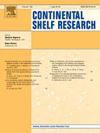Analysis of turbulence characteristics in a nearshore area beyond the surf zone of a mesotidal bay
IF 2.2
3区 地球科学
Q2 OCEANOGRAPHY
引用次数: 0
Abstract
Turbulence impacts renewable energy converters’ performance due to differences in turbulent kinetic energy (TKE) production and TKE dissipation in estuarine, coastal, and shelf regions. However, the turbulence structure under different environmental forcings is not well understood. This study uses waves, tides, and wind data to analyse the mean flow field and turbulence characteristics in Todos Santos Bay (TSB), a mesotidal bay in the northern Mexican Pacific. The main results are based on a month-long time series obtained with a Sentinel V50, a five-beam Acoustic Doppler Current Profiler (ADCP), installed in a location within the bay where currents are less than 0.55 m s−1. A tidal decomposition analysis of sea level and current data confirmed mixed and predominantly semi-diurnal tides. Waves and wind stresses affect the flow in the layers near the sea surface. We computed the Reynolds stresses, TKE, anisotropy, TKE production and TKE dissipation to characterize the turbulence properties. The zonal vertical Reynolds stress increases from the bottom upwards, while the meridional vertical Reynolds stress decreases from the bottom upwards. The turbulent kinetic energy increases from the bottom upwards. The waves do not significantly affect the Reynolds stresses, the TKE, or the anisotropy ratio when the significant wave height is less than 0.7 m. It is worth highlighting that strong wave conditions have an important effect on the turbulence characteristics of the site, even during spring tides. In addition, turbulent processes change with time following flood and ebb tides in the bay, and the TKE and the zonal vertical Reynolds stress are higher during neap tides than during spring tides. Finally, TKE budget computations showed that TKE dissipation dominates over TKE production, implying the existence of non-local transport to the TKE budget at the site; these turbulence metrics are enhanced during neap tides.
中潮湾冲浪带以外近岸地区湍流特性分析
由于河口、海岸和陆架区域湍流动能的产生和耗散存在差异,湍流对可再生能源变流器的性能产生影响。然而,人们对不同环境力作用下的湍流结构还不是很了解。本研究利用波浪、潮汐和风数据分析了墨西哥太平洋北部中潮汐湾Todos Santos湾(TSB)的平均流场和湍流特征。主要结果基于Sentinel V50(五波束声学多普勒电流分析器(ADCP))获得的长达一个月的时间序列,该仪器安装在海湾内电流小于0.55 m s - 1的位置。对海平面和海流资料的潮汐分解分析证实了混合和主要的半日潮。波浪和风的应力影响着海面附近各层的流动。我们计算了雷诺数应力、TKE、各向异性、TKE产生和TKE耗散来表征湍流特性。纬向垂直雷诺应力自下而上增大,经向垂直雷诺应力自下而上减小。湍流动能从底部向上增加。当有效波高小于0.7 m时,波对雷诺数应力、TKE和各向异性比的影响不显著。值得强调的是,强波条件对场地的湍流特性有重要影响,即使在大潮期间也是如此。此外,湍流过程随涨潮和退潮而随时间变化,小潮时期的TKE和纬向垂直雷诺应力均高于大潮时期。最后,TKE预算计算表明,TKE耗散大于TKE产生,表明存在向现场TKE预算的非局部运输;这些湍流指标在小潮期间得到加强。
本文章由计算机程序翻译,如有差异,请以英文原文为准。
求助全文
约1分钟内获得全文
求助全文
来源期刊

Continental Shelf Research
地学-海洋学
CiteScore
4.30
自引率
4.30%
发文量
136
审稿时长
6.1 months
期刊介绍:
Continental Shelf Research publishes articles dealing with the biological, chemical, geological and physical oceanography of the shallow marine environment, from coastal and estuarine waters out to the shelf break. The continental shelf is a critical environment within the land-ocean continuum, and many processes, functions and problems in the continental shelf are driven by terrestrial inputs transported through the rivers and estuaries to the coastal and continental shelf areas. Manuscripts that deal with these topics must make a clear link to the continental shelf. Examples of research areas include:
Physical sedimentology and geomorphology
Geochemistry of the coastal ocean (inorganic and organic)
Marine environment and anthropogenic effects
Interaction of physical dynamics with natural and manmade shoreline features
Benthic, phytoplankton and zooplankton ecology
Coastal water and sediment quality, and ecosystem health
Benthic-pelagic coupling (physical and biogeochemical)
Interactions between physical dynamics (waves, currents, mixing, etc.) and biogeochemical cycles
Estuarine, coastal and shelf sea modelling and process studies.
 求助内容:
求助内容: 应助结果提醒方式:
应助结果提醒方式:


